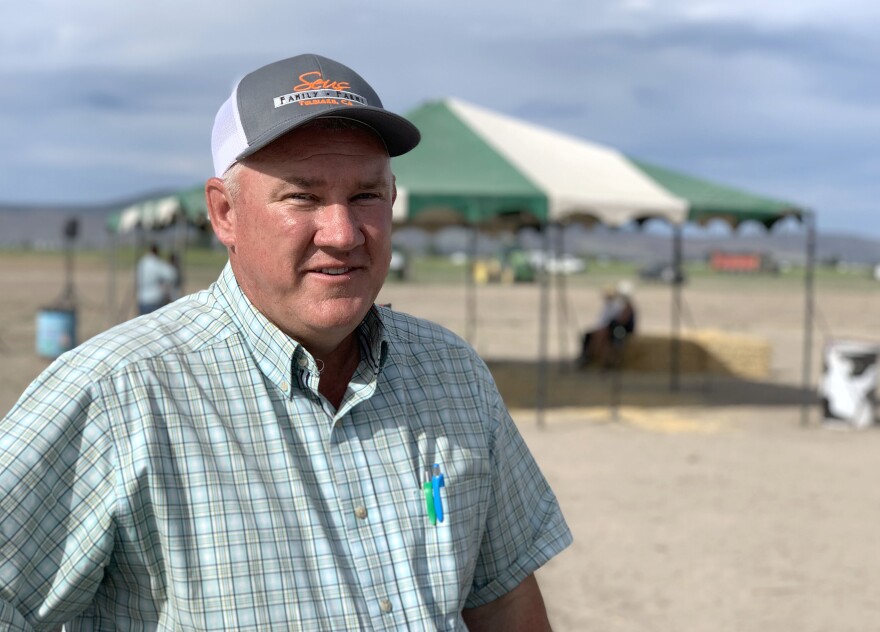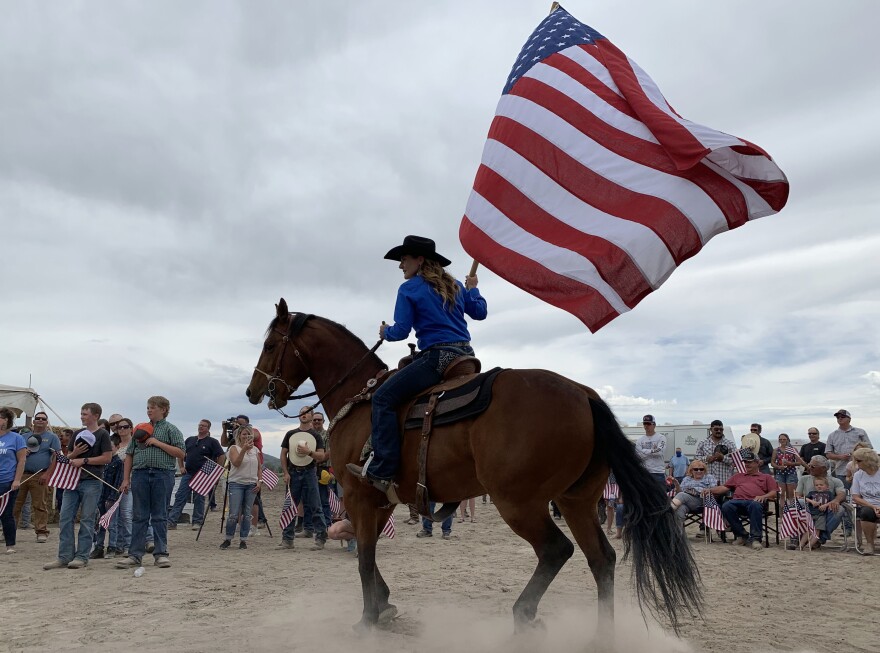Hundreds of John Deere tractors, combines and truck and horse trailers file into a dusty farm field in Midland, Oregon, 10 miles north of the California border. Clouds of dust hang in the air as more vehicles arrive from a miles-long convoy backing up the two-lane road.
One by one, local politicians, farmers and ranchers like Ty Kliewer climb onto a flatbed semi-trailer-turned stage to talk about the threat the drought poses to their livelihoods.
“We know that this is going to be a rough summer,” Kliewer says. “We’re gonna watch our crops shrivel up and die and we will see our calves get thinner and thinner with their mothers when their feed runs out four months early this year.”
The rally, dubbed the “Shut Down and Fed Up” convoy was organized after a recent announcement that farmers in the Klamath Basin would be getting around 20% of their usual water allotment from Upper Klamath Lake.
“This year the concerns are survival. It’s that simple,” says Scott Seus, one of the rally organizers and a third-generation farmer in the Klamath Basin.

“We find ourselves here every year trying to split the baby and it doesn’t work. There’s demands in the lake and below the lake. And we’re out here in the middle,” he says.
In May, federal water managers with the Bureau of Reclamation realized their previous estimate for how much water was available was too high. But farmers had already bought seeds and planted their crops.
2020 is becoming reminiscent of another drought year in 2001. That’s when farmer protests known as the “Bucket Brigade” took place to show the plight of the region’s farms.
Still, farmers are just one water user in a complicated balancing act in the Klamath Basin. Several species of fish in the Klamath River and Upper Klamath Lake also rely on that water.
“Historically, the fish have gotten, I’d say, the shorter end of the stick,” says Dave Bitts, a longtime commercial fisherman in Eureka, California. Until recently Bitts was the president of the Pacific Coast Federation of Fishermen’s Associations.
“The irrigators may feel that they don’t get enough but the fish definitely don’t get enough,” Bitts says.
This year 90% of the Klamath River’s juvenile Chinook salmon are expected to die from a parasite called C. shasta that lives in warm water. Getting more cold water into the river, the fishermen’s association says, could prevent an entire generation of salmon from dying.
Both the Klamath River’s Chinook and federally endangered Coho salmon are culturally important to Northern California’s Yurok Tribe.
“If we lose our salmon, if we lose our river, who we are is gone,” says Frankie Myers, Vice Chair of the Yurok Tribe. “We’re talking about the extinction of a people who have been here since time immemorial.”
This year, all sides are frustrated about the lack of water. And while many say it’s not about farmers versus fish, there are different ideas about the long-term solution.
“My view is, it’s time for a complete reset,” says outgoing Oregon Rep. Greg Walden speaking at the rally. Like some farmers here, he says the federal government should redraft the current water plan because it’s not working for anyone.

“What is going on in this basin such that the fish don’t benefit, the farmers get ruined, and we’re back 20 years later in the same place?” he says, referencing the 2001 drought that led to similar protests.
Myers, with the Yurok Tribe, argues everyone needs to be more realistic about the limited water available in the Klamath Basin.
“In order to survive in the Basin you have to adapt to the landscape around you,” he says. “I think that’s a lesson that everyone has to take to heart. We have to adapt and become sustainable with the resources we have.”
Farmer Scott Seus says the pressures on farmers this year are immense. On top of the water shortage, the coronavirus pandemic has driven down crop prices. He says with such low prices, many farmers can’t afford crop insurance. And, he says, other water sources, like the federally subsidized well water some farmers get, can’t replace the lack of surface water.
Seus hopes federal water managers will reconsider the current water allocation before it’s expected to run out in the next month.
“We’re dying here. We’re not going to survive this, so we’ve got nothing to lose if there’s a hard reset,” he says. “Somebody hits the button and bam this blows up and we start over, we can’t end any worse than we are this year.”




